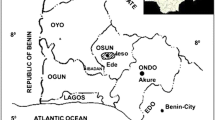Abstract
Direct current (DC) Schlumberger resistivity sounding and dipole-dipole resistivity profiling experiments were conducted at the border of an 2.2 long×1 km wide open waste disposal site in central Jordan. The site is on an approximately 20 m thick limestone, chert and chalk rock sequence and is surrounded by a series of hills. Lying upstream of an urban area, agricultural land and numerous groundwater wells, any contamination spreading from the waste disposal site could have a serious effect on the people and the environment. In this study, the subsurface resistivity distribution was mapped and compared with the data obtained from boreholes and aerial photographs. DC resistivity methods were found to be a fast and inexpensive data collection tool. The results obtained will be of use for engineering preparations and the operation of the site, as well as for monitoring any future pollution.
Résumé
Des sondages électriques verticaux par la méthode Schlumberger et des traînés de résistivité par la méthode dipole-dipole ont été réalisés aux limites d’un site de stockage de déchets de 2,2 km de long et de 1 km de large en Jordanie centrale. Le stockage repose sur une série d’environ 20 m d’épaisseur de calcaires, concrétions siliceuses et craie, et le site est entouré de collines. Le site étant situé en amont d’une zone urbaine, d’une zone agricole et de nombreux puits d’alimentation en eau, toute contamination issue du stockage de déchets pourrait avoir de sérieux effets sur la population et sur l’environnement. Dans cette étude, la carte de répartition des résistivités dans le sous-sol a été confrontée aux données fournies par les sondages mécaniques et les photographiques aériennes. Les méthodes de prospection électrique constituent un outil pour obtenir rapidement et à moindre coût un ensemble de données. Les résultats obtenus seront utiles dans les études de conception et de réalisation du stockage ainsi que pour le contrôle futur d’éventuelles pollutions.






Similar content being viewed by others
References
Barjous M (1992) The geology of Ash Shawbak. Map sheet no. 3151 III. Geological Mapping Division, Natural Resources Authority, Amman, Jordan
Benson A, Payne K, Stubben M (1997) Mapping ground-water contamination using DC resistivity and VLF geophysical methods – a case study. Geophysics 62:80–86
Dahlin T (1996) 2-D resistivity for environmental and engineering applications. First Break 14:275–283
Dahlin T, Loke M (1998) Resolution of 2-D Wenner resistivity imaging as assessed by numerical modelling. J Appl Geophys 38:237–249
GCEP (1994) Industrial pollution control project in Jordan. Project component 1. Design of a hazardous waste disposal facility. Vol. 1–4, Internal Report. General Corporation for Environmental Protection (GCEP), Amman, Jordan
Greenhouse J, Monier-Williams M (1985) Geophysical monitoring of ground water contamination around waste disposal sites. Groundwater Monitor Rev 5:63–69
Kalinski R, Kelly W, Bogardi I, Pesti G (1992) Electrical resistivity measurements to estimate travel times through unsaturated ground water protective layers. J Appl Geophys 30:161–173
Karlik G, Kaya M (2001) Investigation of groundwater contamination using electric and electromagnetic methods at an open waste-disposal site: a case study from Isparta, Turkey. Environ Geol 40:725–731
Lien B, Enfield C (1998) Delineation of subsurface hydrocarbon contamination distribution using a direct push resistivity method. J Environ Eng Geophys 2:173–179
Loke M, Barker R (1996) Rapid least-squares inversion of apparent resistivity pseudosection by a quasi-Newton method. Geophys Prospect 44:131–152
Mazac O, Kelly W, Landa I (1987) Surface geoelectrics for groundwater pollution and protection studies. J Hydrol 93:277–294
Meju M (2000) Geoelectrical investigation of old/abandoned, covered landfill sites in urban areas: model development with a genetic diagnosis approach. J Appl Geophys 44:115–150
Mokhtar T, Basyoni M, Sadek H (1995) Siting of a new landfill for solid wastes in the Kingdom of Saudi Arabia. In: Bell R (ed) Proc Symp Application of Geophysics to Environmental and Engineering Problems (SAGEEP 95). Orlando, FL, 23–26 April 1995, Environmental and Engineering Geophysics Society, Englewood, CO, pp 835–842
Ogilvy A, Bogoslovsky V (1979) The possibilities of geophysical methods applied for investigating the impact of man on the geological medium. Geophys Prospect 27:775–789
Ramirez A, Daily W, LaBrecque D, Owen E, Chesnut D (1993) Monitoring and underground steam injection process using electrical resistance tomography. Water Resour Res 29:73–87
Sasaki Y (1992) Resolution of resistivity tomography inferred from numerical simulation. Geophys Prospect 40:453–464
Acknowledgements
The authors wish to acknowledge the support received from the Natural Resources Authority of Jordan, in the form of a SYSCAL-R2 resistivity instrument. The following employees of the Natural Resources Authority of Jordan are thanked for their aid in the collection of field data: O. Jaradat, H. Shakhatreh, M. Abu Qa’ud, Y. Ainbossi, Kh. Mana’seh, and S. Al Khateib. Facilities provided by the Research and Studies Department, Faculty of Graduate Studies and Scientific Research, Al-Balqa’ Applied University are acknowledged.
Author information
Authors and Affiliations
Corresponding author
Rights and permissions
About this article
Cite this article
Batayneh, A.T., Barjous, M.O. Resistivity surveys near a waste-disposal site in the Qasr Tuba area of central Jordan. Bull Eng Geol Environ 64, 285–291 (2005). https://doi.org/10.1007/s10064-004-0238-5
Received:
Accepted:
Published:
Issue Date:
DOI: https://doi.org/10.1007/s10064-004-0238-5




